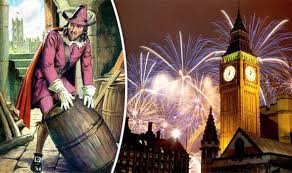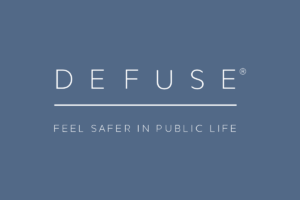A case study of UK’s first and most famous Terrorist plot using The Pathway to Targeted or Intended Violence.
The Gunpowder Plot of 1605.
Every year on the 5th of November, the UK celebrates the flawed attempted terrorist attack on Parliament, commonly referred to as bonfire night or fireworks night. In years gone by children would innocently collect money with a mannequin representing the main terrorist Guy Fawkes, using the term ‘a penny for the Guy’. The culmination of the celebration is a huge bonfire with a ‘Guy’ sat on the top.
The Gunpowder Plot as it is known, has been extensively researched and even today impacts on the event it was targeting, the State Opening of Parliament. That annual event remains the only time that the Monarch, The House of Commons (MPs) and The House of Lords (the Peers) are all assembled in the same place at the same time.
Contemporary behavioural threat assessment methodology includes an element called The Pathway to Targeted or Intended Violence. (The Pathway)
The Pathway was created by two of the godfathers of behavioural threat assessment, Ted Calhoun and Steve Weston.
The model identified six progressive steps that attackers habitually follow and that may be observable by professionals. The is a part of the theory that targeted attackers do not just snap, they plan and follow a process from grievance to attack.

This case study with examine The Gunpowder Plot of 1605 to ascertain whether the way it was planned and executed fits with The Pathway, and if so, would it have been identified using this model.
The Grievance.
This grievance dates to 1533 and 1536 when King Henry 8th initiated an attack on papal authority and English Catholics. In some cases, those adhering to Catholicism faced capital punishment. The anti-Catholic rhetoric was expanded when in 1570 Pope Pius V declared that Queen Elizabeth 1st was not a rightful queen and should be overthrown. It formally excommunicated her and any who obeyed her and obliged all Catholics to attempt to overthrow her.
In response Queen Elizabeth 1st made it high treason for any Jesuit or any seminary priest to be in England at all, and a felony for anyone to harbour or relieve them.
By 1604 English Catholics were persecuted and treated like 2nd class citizens, with those refusing to attend Protestant church services heavily fined.
Ideation.
In May 1604, some 18 months before that planned attack, 5 Catholic men met in the Duck and Drake pub in London. Having concluded that the only way to improve the lives of Catholics was through a violent act. The plan was to blow up the Houses of Parliament on the day of the State Opening of Parliament in February 1605, killing King James 1st together with the most influential men in England. Once successful they then intended to lead an armed Catholic uprising, kidnapping the nine-year-old Princess Elizabeth (Stuart), daughter of King James 1st, and place her on the throne of England as a Catholic monarch.
Because Catesby and others were known to the state as criminals and Catholics, they recruited Guy Fawkes who was unknown to the authorities.
Guy Fawkes was an explosives expert who because he had spent the past decade overseas where he fought for Catholic Spain against Protestant Dutch reformers.
What is clear is the conspirators were fixated on their religious persecution and saw themselves as soldiers of a cause. The plot wasn’t about them, it was for a cause, an ideology far greater than them. In moderns day threat assessment terminology tis can be termed Fixation and Identification.
Research and Planning.
This is the phase in which they plan and research their target and the tactics they were going to use and to plan their attack.
One of the co-conspirators Thomas Percy used his influence as an aristocrat to join the Band of Gentlemen Pensioners, a mounted troop of 50 bodyguards to the King. As a member of the Band of Gentlemen Pensioners, he was expected to take up residence close to Parliament and managed to secure a ‘safe house’ and another of the conspirators to act as his servant under a pseudonym.
They secured lodgings across the river in Lambeth where they stored their explosives, which they could then transport at night by boat.
Suddenly their ‘safe house’ was commandeered by the Government for important state business.
The plan was put on hold until the ‘safe house’ was available again.
Once the plot reconvened in December 1604, the plan was to dig a tunnel under Parliament, and then row their explosives across the river and blow-up Parliament from their hidden tunnel. This gave them just 2 months to complete their tunnel.
Pre -Act Preparation.
This is the phase in which they acquire the weapons, explosives, and other material to ensure a successful mission.
Their plan changed when it was announced that due the plague, the State Opening would be delayed and would now be postponed until November 5th.
Using the postponement, they decided to stockpile their explosives in Lambeth. According to Guy Fawkes, who was tortured following his arrest, 20 barrels of gunpowder were brought in at first, followed by 16 more on 20 July.
Whilst digging their tunnel, they became aware of noise above them. The noise turned out to be the then-tenant’s widow, who was clearing out the Undercroft directly beneath the House of Lords—the room where the plotters eventually stored the gunpowder.
Probing and Breaches.
In the 1600s Parliament was not all one connected building that we know today, it was several dislocated separate buildings, more open with shops and other rooms that were available to rent. Enquiries revealed that the Undercroft cellar was soon to be vacant and available to lease.
It is also worth remembering that barrels were an everyday item back then, and because they were used to store almost everything, it was quite usual to see barrels being rolled into storerooms.
They decided to move the barrels from their storage in Lambeth to their new storeroom across the river overnight. This was a high-risk strategy, but they finally completed this part of the operation on 20th July 1605.
They have now managed to move their huge volume of gunpowder directly under their target, avoiding any security, managing to make it look like any other 1600s storeroom.
As part of the wider plan, Catesby decided to recruit more volunteers for the armed uprising. One of the last men to be recruited was his cousin, Francis Tresham. Tresham has previous experience of such plots and served a prison term during the reign of Elizabeth 1st. He was recruited as he was wealthy, and it was hoped that he would fund the uprising. It is believed that he has reservations about the plot but was nonetheless recruited.
By October 21st, 1605, the team, 13 Catholic men, had all been recruited.
As with every plot, the more people involved the more vulnerable they are to leakage.
At this time in English history King James 1st was paranoid of plots against him, and a spy network, often referred to as the earliest example of the English Secret Service were busy recruiting Catholic priests as informants reporting on Catholic conspirators.
On 26th October 1605, ten days prior to the attack, there was a leak. A letter was sent to Lord Monteagle, a Catholic Peer which has been preserved and exists in the National Archives.
It stated “My Lord, out of the love I bear to some of your friends, I have a care of your preservation. Therefore, I would advise you, as you tender your life, to devise some excuse to shift your attendance at this parliament; for God and man hath concurred to punish the wickedness of this time. And think not slightly of this advertisement but retire yourself into your country where you may expect the event in safety. For though there be no appearance of any stir, yet I say they shall receive a terrible blow this Parliament; and yet they shall not see who hurts them. This counsel is not to be condemned because it may do you good and can do you no harm; for the danger is passed as soon as you have burnt the letter. And I hope God will give you the grace to make good use of it, to whose holy protection I commend you”.
Lord Monteagle shared this letter with King James’s spy chief Sir Robert Cecil, who chose not to act straight away but looked to gather more intelligence.
The source of the leak is believed to have been Francis Tresham. He was a relation of Lord Monteagle, was recruited late into the plot and had expressed doubts of the plan itself.
At the same time a servant of Lord Monteagle sent a message to Catesby informing him of the leak.
A few days later Guy Fawkes returned to the Undercroft to see whether the stored explosives had been discovered. Satisfied that they hadn’t, the plot was still on!
On 1st November 1605 King James ordered the House of Lords to be searched.
The Attack.
On 4th November 1605, the day before that attack, Guy Fawkes returned to the Undercroft to prepare for the following day’s attack, while Catesby headed north to prepare for phase 2, the uprising.
Later that afternoon Guy Fawkes was discovered. He briefly managed to talk his way out of it, stating that he was the servant tasked with looking after the storeroom. Initially his story checked out and he was left alone. It was decided that the plot should continue. The fuse was prepared, and the attack was fully prepared and ready to go.
Just after midnight Guy Fawkes heard noises in the corridor outside the storeroom. He opened the door, and he was captured.
The plot was foiled.
He was taken away and ultimately taken to the Tower of London to be questioned and tortured He lasted 4 days before he was broken, and confessed all.
He was subsequently executed.
All the members of the plot had either been captured or killed, most in a ‘last resort’ shootout at a country house in Staffordshire.
Francis Tresham, believed to have been the source of the leak, was the last to be arrested. In custody he was allowed to receive visitors and a personal visit from a doctor. A letter sent from Lord Cecil to the King refers to Tresham escaping. A few days later he was said to have died in custody.
There were reports of Tresham being seen in France days later and he was later reported to be found living in Spain. Samples of his handwriting were compared to documents back in the UK, and the similarity is considered suggest that are the same.
In 1606 an Act of Parliament was introduced instructing that everyone had to attend a Church service on the 5th November every year as an act of remembrance of the threat.
A nursery rhyme was created to remember the plot.
“Remember, remember the Fifth of November,
The Gunpowder Treason and Plot,
I know of no reason
Why the Gunpowder Treason
Should ever be forgot.
Guy Fawkes, Guy Fawkes, t’was his intent
To blow up the King and Parli’ment.
Three-score barrels of powder below,
Poor old England to overthrow;
By God’s providence he was catch’d (or by God’s mercy*)
With a dark lantern and burning match.
Holla boys, Holla boys, let the bells ring.
Holloa boys, holloa boys, God save the King!
And what should we do with him? Burn him!”
The Act was repealed in 1859.
Conclusion.
Contemporary threat assessment and management has identified the 6 step model The Pathway as a process that many would be attackers will escalate along. This model is as relevant for public figures attackers as it is for terrorists and as such forms part of the TRAP-18 (Terrorist Radicalization Assessment Protocol). The model is based on human behaviour, and this case study demonstrates that as far back as 1605, the behaviours of those fixated on an ideology or cause and who became intent on a violent solution, followed the same process. What this says to me is that the tactics and causes of terrorists may have changed over the past 418 years, but the methodology of their attack planning and the behavioural indicators remain the same. This demonstrates that the value of the Pathway is as relevant today as ever and will continue to be relevant in the future too.



